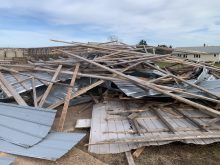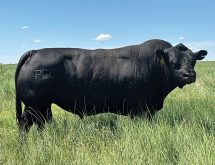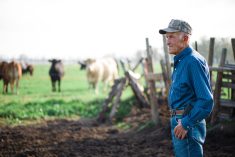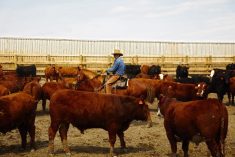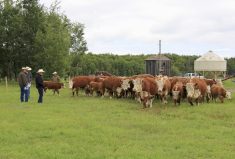Even for those raised on a ranch, there’s always a learning curve in the beef industry. Third-generation rancher Holly Sparrow is leveraging what she’s learned on the farm and in school with her work and board experience to climb that curve.
Sparrow’s passion for the beef industry is rooted in her experience on her family ranch, Tee Two Land and Cattle at Kelliher, Sask. She earned an animal science degree from the University of Saskatchewan and is currently working alongside her parents and brother on their mixed operation. She is also involved in the Saskatchewan Forage Council and is passionate about nurturing a sustainable environment while producing high-quality beef.
Read Also

A strategic approach to risk on the ranch
Given the increase in the value of livestock and the market volatility, we need to cover our risks. First,…
Holly and her husband Devin Sparrow married in February and now live near Vanscoy, Sask. They are excited about their future and their opportunities with beef cattle and grain farming. The couple has a small cow herd of their own.
Devin works full-time with his father on their family’s mixed operation, VJS Ag Corp. Sparrow travels between Kelliher and Vanscoy, a three-hour drive between the two places.
Since September 2020, Holly’s also been an assistant provincial co-ordinator with Saskatchewan’s Verified Beef Production Plus (VBP+), and recently started covering a maternity leave as an audit co-ordinator with the national program. The job allows her to work from home as she fields producer inquiries about the program, facilitates informative webinars about the voluntary program, helps producers move towards certification and sends them information about programs linked to VBP+.

The program validates the protocols ranchers have implemented around bio-security, animal care, environmental stewardship and food safety.
“Most beef operation practices already meet these requirements, but this third-party on-farm audit validates the industry standards.”
Crops and cattle
The Thompson family ranch, Tee Two Land and Cattle, is a mixed cattle/farming operation that includes Sparrow’s grandparents, who bought the first quarter-section in 1951.
“My parents joined the operation in 1989. Today more of the family is involved — my parents and my oldest brother Cole are full-time on the operation, and I’m there part-time. During the busy seasons like calving, weaning, harvest, silaging, etc., I am there full-time.”
Sparrow’s youngest brother, Adam, also recently joined the operation after finishing his agriculture degree through Olds College. The family also has three full-time employees. “We have a really great crew,” says Sparrow.
“I’ve been fortunate to have the life that I do, thanks to my grandparents and parents’ work ethic, and their passion for the land and animals. These role models have continually shown me the quality of life in this industry and that it is always worth advocating for. Being able to ranch so closely with my family has been a real blessing.”

Tee Two Land and Cattle comprises 9,500 acres, with half of it in crop production and the other half grass and silage. They run about 1,200 mother cows, plus a backgrounding lot and a small finishing lot. The cow herd is crossbred with an Angus base.
“I learned from my dad that the goal is not achieving the highest weaning weight just to hit a high market price. We focus on the bigger picture, measuring our net profit per acre. We want our cattle to be good roughage converters, able to utilize what our farm grows as a mixed operation. They graze the crop residues and forages and have a very symbiotic relationship with our land.”
As an example, during harvest, the chaff wagons are pulled around to strategically drop crop residue piles to stockpile for winter feed in pastures where cattle are moved around.
“We haul a TMR supplement to those chaff piles, and this enables us to utilize our cropland byproduct with the cattle and have them convert low-quality roughage into nutrient-dense, high-quality beef.”
By strategically placing the piles in places such as hilltops or other low-production areas, they can best use the fertilizer the cattle add to the land. Crops and cattle make a good mix, and she feels that any grain farm can have an opportunity to incorporate cattle, if they truly want to, and can address the capabilities of buying feed or growing it.
“A farmer who decides to incorporate cattle has opportunity to optimize their land through more than one harvest season. However, there are always challenges to be addressed with different land and soil types, such as land location and access to water and shelter. I try to think how we can make this work and what barriers are we facing.”
Some grain farmers can benefit by working with a neighbour and do some exchanges that work well for both of them.
“It’s definitely a win-win when you can work with a neighbour. The cattle producer can feed cattle on someone else’s resources, and that neighbour can have the cattle impact, which adds fertility to the soil, and extra revenue from renting out the land during a non-harvesting window.”
Her husband’s family farm is also a mixed operation of grain and cattle. “There are many opportunities to figure out how to use our own cattle to utilize some of the cropland. Although both farms are in Saskatchewan, the land is quite different. Tee Two is in pothole country with water sources everywhere. This makes dividing pastures easier.”
Sparrow’s work with VBP+ is opening her eyes to the programs available to producers to address some of the challenges facing their operations.
“Every operation is unique, and there is no instruction book to tell us step-by-step how to get through some of these difficult scenarios. If we think outside the box about our own operations and what resources we have available, there is opportunity to build a successful operation.”
From the Prairies to Parliament Hill
Growing up on the ranch helped build deep roots in the cattle industry, and being able to work on a mixed operation at home gave her experience and a passion for cattle.
“I gained a huge respect for the beef industry and decided to go into it deeper. I knew I wanted to have a career in the beef industry and be a part of it.”
After graduation, she became the Saskatchewan rep for the Canadian Cattlemen’s Association Young Cattlemen’s Council (YCC). “This has been a great learning experience. I jumped into it, not really knowing what it was all about, but I am glad that I did.”
Sparrow served as president of the YCC for two years, and is currently the past president. Her time on the committee allowed her to connect with people from across Canada.
“I’ve been able to lobby on Parliament Hill and discuss pressing issues with our own and other industries. I’ve also been able to advocate for young producers across Canada.”

Although YCC pushed her outside her comfort zone at times, she learned and enjoyed being part of the industry committees more than she’d expected. Sparrow says that the beef industry is pleased to see young voices coming on board and has been good at encouraging participation from the YCC.
“The value a person gets from these (committees) outweighs any uncomfortable moments. Our industry is very welcoming and the people within it have similar end goals and are open to discussions.”
Sparrow sees both challenges and opportunities for young people in this industry. Land prices are high and there’s plenty of competition, especially for those close to a city.
“It’s difficult to build enough operating capital, and costly to enter this industry. It comes with a lot of risk. Having things like business risk management programs available to young producers is an important tool.”
Connecting with other people can also be challenging for people in the industry.
“I know that many ranchers say they are happiest when they are out with their cows, but it is very important to have connections with other folks in the industry. This is helpful not only from a learning standpoint but also for friendship.
“In rural areas, especially today with COVID, some people feel alone. They need to be encouraged to reach out and push themselves out of their comfort zones and join these wonderful groups. Sometimes knowing where to start or how to get involved can be a challenge for young producers.”
Some of the opportunities she sees for young people include the potential for many satisfying careers. “The beef industry has many opportunities, and getting involved is just a step closer to that great career path, and the high quality of life we know that we can have.”
Anyone interested in learning more about YCC or becoming involved in other programs can contact Sparrow via email at [email protected].



